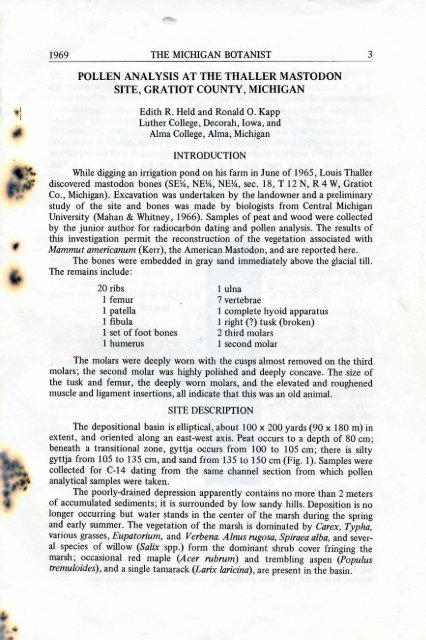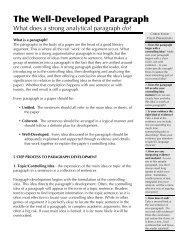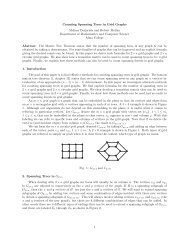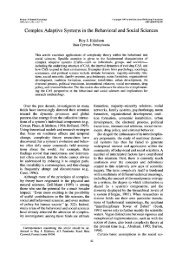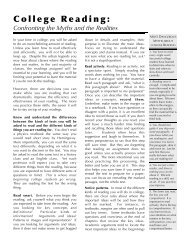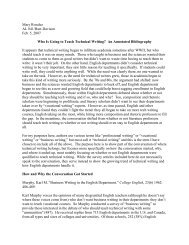POLLEN ANALYSIS AT THE THALLER MASTODON ... - Alma College
POLLEN ANALYSIS AT THE THALLER MASTODON ... - Alma College
POLLEN ANALYSIS AT THE THALLER MASTODON ... - Alma College
Create successful ePaper yourself
Turn your PDF publications into a flip-book with our unique Google optimized e-Paper software.
1969 <strong>THE</strong> MICHIGAN BOTANIST3<strong>POLLEN</strong> <strong>ANALYSIS</strong> <strong>AT</strong> <strong>THE</strong> <strong>THALLER</strong> <strong>MASTODON</strong>SITE, GRAnOT COUNTY, MICHIGANEdith R. Held and Ronald O. KappLuther <strong>College</strong>, Decorah, Iowa, and<strong>Alma</strong> <strong>College</strong>, <strong>Alma</strong>, MichiganINTRODUCTIONWhile digging an irrigation pond on his farm in June of 1965, Louis Thallerdiscovered mastodon bones (SE~, NE~, NE~, sec. 18, T 12 N, R 4 W, GratiotCo., Michigan). Excavation was undertaken by the landowner and a preliminarystudy of the site and bones was made by biologists from Central MichiganUniversity (Mahan & Whitney, 1966). Samples of peat and wood were collectedby the junior author for radiocarbon dating and pollen analysis. The results ofthis investigation permit the reconstruction of the vegetation associated withMammut americanum (Kerr), the American Mastodon, and are reported here.The bones were embedded in gray sand immediately above the glacial till.The remains include:20 ribsI femurI patella1 fibula1 set of foot bones1 humerusI ulna7 vertebrae1 complete hyoid apparatusI right (?) tusk (broken)2 third molarsI second molarThe molars were deeply worn with the cusps almost removed on the thirdmolars; the second molar was highly polished and deeply concave. The size ofthe tusk and femur, the deeply worn molars, and the elevated and roughenedmuscle and ligament insertions, all indicate that this was an old animal.SITE DESCRIPTIONThe depositional basin is elliptical, about 100 x 200 yards (90 x 180 m) inextent, and oriented along an east-west axis. Peat occurs to a depth of 80 cm;beneath a transitional zone, gyttja occurs from 100 to 105 cm; there is siltygyttja from 105 to 135 cm, and sand from 135 to 150 cm (Fig. 1). Samples werecollected for C-14 dating from the same channel section from which pollenanalytical samples were taken.The poorly-drained depression apparently contains no more than 2 metersof accumulated sediments; it is surrounded by low sandy hills. Deposition is nolonger occurring but water stands in the center of the marsh during the springand early summer. The vegetation of the marsh is dominated by Carex, Typha,various grasses, Eupatorium, and Verbena. Alnus rugosa, Spiraea alba, and severalspecies of willow (Salix spp.) form the dominant shrub cover fringing themarsh; occasional red maple (Acer rubrum) and trembling aspen (Populustremuloides), and a single tamarack (Larix laricina), are present in the basin.
4<strong>THE</strong> MICHIGAN BOTANISTVol. 81969<strong>THE</strong> MICHIGAN BOTANIST5Second-growth and selectively cut woodlands near the excavation site,and at Lumberjack Park in the same section, provide an indication of thecomposition of the upland forests that surrounded the depositional basin beforesettlement. Well-drained sandy sites are dominated by white pine (Pinus strobus),with occasional hemlock (Tsuga canadensis), big-toothed aspen (Populusgrandidentata), and white oak (Quercus alba); the understory is dominated bywitch hazel (Hamamelis virginiana) and juneberry (Amelanchier sp.). On morepoorly drained sites red maple (Acer rubrum) is dominant, with white pine andpaper birch (Betula papyri[era) frequent; red oak (Q. borealis), white oak,swamp white oak (Q. bicolor), wild black cherry (Prunus serofina), sugar maple(Acer saccharum), and hemlock are occasionally present. These observations andprevious studies of the presettlement forests in nearby Richland Twp., MontcalmCo. (Hushen, et aI., 1966), indicate that the area was originally heavily forested30 em:90 em:120 em:150 em:gray. sand',A Ii. ~till7120 t 250 B.R(wood)7220± 250 B.P.(wood)73901' 280 8. P.(pea t)11200 :t 400 B. P.(9yttja)9910± 350 B. P.(bone)Fig. 1. Sedimentary sequence at the Thaller mastodon site. Left column shows depths ofthe samples analyzed; C-14 dates are shown at the right at the appropriate depths.with white pine; mixed hardwood and hemlock forests occupied moist sites inpresettlement times.METHODSSamples were collected from the exposed face of the excavation at 5 cmintervals to a depth of 150 cm. Samples for pollen analysis were placed in glassvials in the field; the open vials were pushed into the freshly exposed sedimentsto prevent contamination. Peat and wood samples were sealed in polyethylenebags.Calcareous samples were flooded with 6% HCI to remove carbonates. Allsamples for pollen analysis were processed according to the standard acetolysisprocedure (heated to boiling in 9: 1 mixture of acetic anhydride and concentratedsulfuric acid) and the concentrated residue was suspended in glycerinejelly for storage and slide preparation.Pollen counting was performed at 100 diameters magnification due to thehigh percentage of pine and spruce; small or difficult entities were studied at 450or 950 X. Counting was continued along regular traverses of the mechanicalstage until approximately 200 pollen grains (excluding sedges and aquatic plants)had been tallied. At 140 cm a full count was not tallied because, possibly due toa rapid rate of sedimentation, pollen grains were very scarce. At 145 and 150 cmpollen was absent.RESULTSThe results of pollen analysis are presented in the pollen diagram (Fig. 2),which includes those entities which are consistently or abundantly representedin the samples. Cyperaceae (sedge) and aquatic species, which are of restricteddistribution near the depositional site and are frequently overrepresented, areexcluded from the pollen sum. Percentage frequencies are based on the pollensum and are plotted for each stratigraphic level and then connected vertically togive a pollen profile for each of the pollen types. Frequencies of Cyperaceae,aquatic plants, and ferns are calculated as percentages of the pollen sum, eventhough they are excluded from the sum. Percentages of infrequent pollen andspore types are shown in Table I. Of particular interest in this table is theoccurrence of TWa and Tsuga throughout the record and the identification of asingle grain ofLinum (flax) pollen from the 140 cm level.Samples of wood collected from the peat zone were identified by microscopicexamination. Three types were recovered: Pinus strobus, Picea sp., andFraxinus sp.Radiocarbon dates on samples of peat, wood, and mastodon bone (innertusk) are given in Fig. 1.DISCUSSIONThere is a general trend from high (greater than 50%) to lower (less than30%) spruce pollen in the record. This is similar to other sequences from Michiganwhich typically have an early Picea-dominated zone which began soon afterdeglaciation and ended between 8,000 and 10,000 years B.P. (Andersen, 1954;
6<strong>THE</strong> MICHIGAN BOTANISTVol. 8Zumberge and Potzger, 1956; Gilliam, et al., 1967; Kapp, ms.).Characteristic of the Spruce Pollen Zone are high percentages ofPicea andnonarboreal pollen (NAP). Abies is present only in this zone; this is consistentwith other late-glacial pollen records from Michigan. The Thaller diagram hassignificant percentages of Ambrosia and Artemisia in the Spruce Pollen Zone;these herbs, along with some of the composites (Compositae) and grasses(Grarnineae), probably occupied ecologically disturbed and open habitats withinthe spruce forest.The Pine Pollen Zone (Zone II, Fig. 2) is characterized by high percentagesof pine and fern spores and low percentages of spruce and NAP.Typically, a Hardwood Pollen Zone follows the Pine Pollen Zone in pollendiagrams from the region. At Vestaburg Bog, only 6 miles from the Thaller farm,the Hardwood Pollen Zone begins about 8,000 B.P. and is characterized by highpercentages of Quercus and other hardwood pollen types. In the Thaller pollendiagram the Hardwood Zone is subdued by local overrepresentation of pine andspruce pollen. Black spruce (Picea mariana) apparently persisted after the beginningof the postglacial period at about 10,000 B.P. and probably increased incover; this is reflected in the increase in the spruce pollen percentages (from 45to 5 cm). The high pine pollen frequency in Zone II is due to the abundance ofwhite pine on the surrounding hills; a similar forest composition persists to thepresent at nearby Lumberjack Park (located*mile southwest of the site) and atnearby Thaller's woods. The postglacial persistence of spruce at the site, and thelocal occurrence of white pine, is confumed by the discovery of wood of thesetrees in the peat zone.Modern pollen rain studies from moss polsters in Thaller's woods haveyielded pollen spectra with high pine and low hardwoods (Fig. 1, upper spectra).Picea is much less prominent in the modern pollen rain when compared with theperiod 7,300-7,100 B.P.; spruce trees are now very infrequent in this vicinity.The stand of spruce in the Thaller peat bog must have disappeared subsequent tothe time that deposition ceased. Comparison of the modern and fossil pollenspectra substantiates the foregoing interpretation of the Pine Pollen Zone andexplains the paucity of the hardwoods in the record.Ecological succession gradually changed the site from lake to bog to aseasonally wet marsh. The presence of Sagittaria and Nuphar in the lowest levelsubstantiates the existence of a small shallow lake in late-glacial time. Thechange from lake to bog is inferred from the changing composition of thesediments. Gray sand and gyttja immediately above the glacial till indicate thepresence of an alkaline lake; the gradual transition to peaty gyttja and subsequentlypeat reflects the change to bog, and later marsh, conditions. A substantialincrease in the frequency of fern spores in the upper zone is probably relatedto increased dryness associated with this succession. Sediments stopped accumulatingwhen the bog filled in completely about 7,000 years B.P.Gilliam, et al. (1967) conclude that Tsuga migrated into Montcalm Countyabout 8,000 years B.P.; yet Tsuga was present in the Thaller farm about 10,000B.P. (120 cm). Assuming that Tsugacould not have entered Michigan from thesouth because of the presence of the prairie peninsula (Benninghoff, 1964),1969'"zoN.........EuaC"'l<strong>THE</strong> MICHIGAN BOTANIST-snuld__.-L ---:- T~E uoCDE ua0>...7
<strong>THE</strong> MICHIGAN BOTANISTVol. 8 1969 <strong>THE</strong> MICHIGAN BOTANIST 9S~N~N ..::rNCO~C:ON~...-t,....,,...... """'\0\0 \0 CX) -4''''l/'l1J''\0'\'"these central Michigan records suggest that hemlock entered the state from theN..-iO "''''N~..-i O"";OON"";NNOO 0 00000 "";000""; 00"";l::::east or north rather soon after deglaciation. Fagus pollen occurred at 95 em~ ·I~Ol~ Ol ....... QJ eu~ ~OfQJ Q.I .....Ql ..-i Ql Ql a a Ql Ql ..-i ..-i OlI-< I-< Ol I-< I-
10 <strong>THE</strong> MICHIGAN BOTANIST Vol. 8were embedded in the peat which was deposited during the Pine Pollen Period at the site.This explanation is confIrmed in modern pollen rain studies from moss polsters near the site.Radiocarbon dates of peat, wood, and gyttja range from 7,120 ± 250 B.P. to11,200 ± 400 B.P. The date (9,910 ± 350 B.P.) on the bone is open to question because itwas lying in sand stratigraphically lower than the gyttja, yet the bone has a younger date.ACKNOWLEDGMENTSThese investigations were supported by the National Science Foundation-UndergraduateResearch Participation program (Grant GY-2871). Appreciation is extended to theMichigan Memorial Phoenix Project Radiocarbon Laboratory for providing the C-14 dates.Thanks are extended to Mr. and Mrs. Louis Thaller for their continuous cooperation. Thefacilities of the Department of Biology, <strong>Alma</strong> <strong>College</strong>, were used throughout.LITER<strong>AT</strong>URE CITEDAnderson, Sv. Th. 1954. A late-glacial pollen diagram from southern Michigan, U.S.A. DanmarksGeol. Undersc,jgelse II (80): 140-155.Benninghoff, W. S. 1964. The prairie peninsula as a filter barrier to postglacial plant migration.Proc. Indiana Acad. 72: 116-124.Brown, J., & C. Cleland. 1968. The late glacial and early postglacial faunal resources inbiomes newly opened to human adaptation. In The Quarternary of Illinois, a Symposium(Univ. Ill., Coll. Agr. Spec. Publ. 14), pp. 114-122.Gilliam, Jeanne A., R. O. Kapp, & R. D. Bogue. 1967. A post-Wisconsin pollen sequencefrom Vestaburg Bog, Montcalm County, Michigan. Pap. Mich. Acad. 52: 3-17.Hushen, T. W., R. O. Kapp, R. D. Bogue, & J. T. Worthington. 1966. Presettlement forestpatterns in Montcalm County, Michigan. Mich. Bot. 5: 192-211.Kapp, R. O. (manuscript). Pollen and macrofossils associated with the Rappuhn Mastodon,Lapeer County, Michigan.Mahan, H., & M. Whitney. 1966. Preliminary report on the Thaller mastodon of GratiotCounty. (Unpublished report to Mich. Acad., 70th Annual Meeting.)Martin, P. S. 1967. Pleistocene overkill. pp. 75-120 in Pleistocene Extinctions, ed. by P. S.Martin & H. E. Wright, Jr. Yale Univ. Press, New Haven.Skeels, M. A. 1962. The mastodons and mammoths of Michigan. Pap. Mich. Acad. 47:101-132.Zumberge, J. H., & J. F. Potzger. 1956. Late Wisconsin chronology of the Lake Michiganbasin correlated with pollen studies. Bull. Geol. Soc. Am. 67: 271-288.


